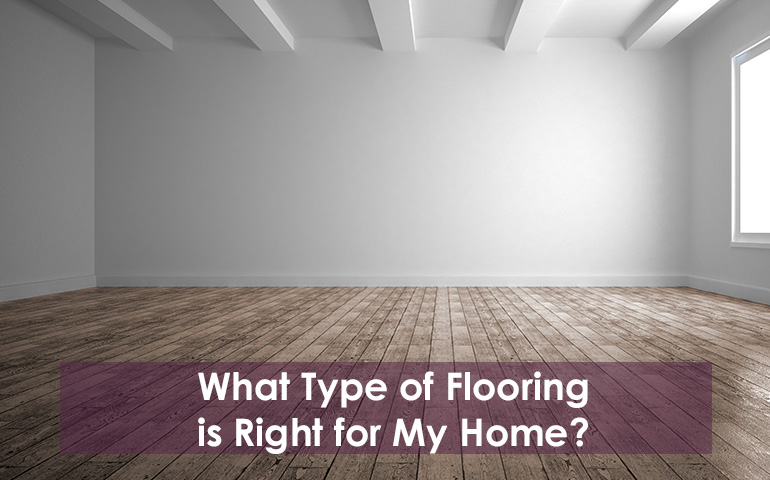
What Type of Flooring is Right for My Home?
by Chris Petry
You walk on it. Your pets walk on it. Your kids throw their toys and their clothes on it. While it’s unlikely that floors will ever experience the same attention and reverence heaped upon professionally-edged counter tops, or the immediate wow factor of a multi-story window installation, they’re, arguably, the most important feature of all. It’s far and away the most utilized component of your home.
If there’s anything more important than a well-installed and maintained floor, it’s knowing what kind of floor is most appropriate for the type of space it will be applied. Below, we’ve listed five of the most popular types of flooring, as well as suggestions for what type of flooring should be implemented in each room of your house. Certainly, an important factor to consider if you’re considering buying a new home or selling the one you have!

Hardwood- The golden standard of home flooring, hardwood floors have rarely fallen out of style over the decades. Their durability, the ease of restoration, and classical aesthetic appeal have ensured their continual presence in new and old homes alike. Solid hardwood planks are cut from a single piece of lumber, unlike engineered hardwood floors which are made up of multiple layers of wood, glued together. An increasingly popular, and more environmentally friendly, option is bamboo flooring. Bamboo grows much faster than traditional timber and is thus more replaceable, resulting in a lesser impact to forest ecosystems.
If there’s one downside to hardwood and bamboo-style flooring, it’s that it can be quite costly. Still, it’s a timeless and dependable flooring option that can be used in bedrooms, small powder rooms, living and dining rooms and kitchens.

Laminate- Laminate floors are composed of synthetic wood planks, with tongue and groove connectors, making for a relatively easy installation, regardless of the installer’s level of skill or experience. Laminate floors are fairly durable and may come readymade with fixed shock-absorbing underlayment. Many brands and types advertise some level of waterproofing, making them a cost-effective option for a variety of spaces.
Downsides are a shorter lifespan when compared to traditional hardwood and the inability to repair or resurface damaged planks. Laminate can be used practically anywhere: bedrooms, bathrooms, living and dining rooms, kitchens, and even basements.

Tile- Tile is a manufactured material, most usually in a square or rectangular shape, that is laid and secured with the aid of concrete or grout. Tiles can be made of a variety of materials, including: ceramic, stone, clay, metal, vinyl, and more. The major benefits of a tile floor are the durability and ease of cleaning, while the negatives are the difficulty of replacing cracked or damaged tiles and the fact that, if you’re self-installing, you’ll need a special tile-cutting wet saw to cut and shape said tiles. Not to mention, you’ll need to mix your own mortar and pay extra attention to the levelness of the applied tiles. Unevenly applied grout and concrete can offset them, even on a level subfloor.
Where should you install a tile floor in your home? Bathrooms and kitchens are the usual go-to spots because the aforementioned ease of cleanup, as are basements because of their resilience in environments with regular moisture. Entryways are also a common location, giving folks the chance to remove dirty or soiled shoes and clothing before proceeding to wooded or carpeted areas.

Vinyl- Vinyl flooring is one of the most cost-effective home flooring solutions. It’s easy to clean and most varieties can withstand sitting water for reasonable periods of time without long-term damage. Vinyl flooring can come in plank form or in sheet form, wherein it’s laid much like carpet. Except with the aid of an adhesive as opposed to tacking strips. Damaged sections are fairly easy to replace if need be. The downside is that it has neither the character, look, or feel of a natural floor type like wood or stone. Designs can, at best, emulate wood grain or tile at a glance but never come close to matching the texture or porousness of the real deal.
Where can you apply vinyl in your home? Practically anywhere. If you’re remodeling on a budget and need a quick low-cost solution for a small bathroom, concrete basement, pet space, or storage area, it’s a sound choice.

Carpet- Oh, carpet! We love thee. We despise thee. Carpet has mostly fallen out of fashion in communal areas of the home, such as living and dining rooms but it still has its utility. Even those who have repudiated its use in the above-mentioned spaces, might still appreciate its presence in bedrooms. Why? It retains temperature well and it’s shock absorbent. Which is to say, you’re less likely to break that lamp or glass of water if it takes a tumble. The bad side? It’s tough to clean. Especially if you spill, say wine or tomato products, on a white, grey, or beige colored carpet. If you have pets… it can be a challenge. Carpet retains odors making it more likely your pet will become a repeat offender near the same stretch of carpet. After all, their keen little noses can usually smell right through the lemon, floral and baking soda fragrances you’ve used to mask the incident.
Where can you apply carpet? Avoid areas with excessive moisture, such as bathrooms, laundry rooms, and kitchens. Reserve carpets for bedrooms, offices and dens. Remember, if you plan to sell your home in the near future, few things are likely to turn off prospective buyers more than old or soiled carpets.
We hope this information has been helpful in deciding what floor type is right for your next remodel. For more information, speak to a professional contactor or installer before making your final decision. If you need a new home before you can even begin thinking of a remodel, speak to a real estate professional from your local branch of Berkshire Hathaway HomeServices The Preferred Realty.





